Advertisements
Advertisements
Question
Given below is a diagram showing a defect of vision. Name the defect of vision and draw an accurately labelled diagram to correct this defect.
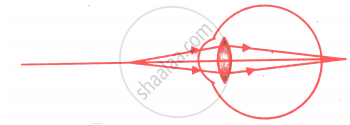
Solution
Name of defect: Farsightedness or hypermetropia
Correction of Farsightedness:
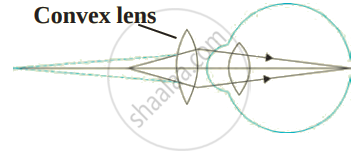
APPEARS IN
RELATED QUESTIONS
Millions of people in the developing countries of the world are suffering from corneal blindness. These persons can be cured by replacing the defective cornea with the cornea of a donated eye. A charitable society of your city has organised a campaign in your neighbourhood in order to create awareness about this fact. If you are asked to participate in this mission, how would you contribute in this noble cause?
(i) State the objective of organising such campaigns.
(ii) List two arguments which you would give to motivate the people to donate their eyes after death.
(iii) List two values which are developed in the persons who actively participate and contribute in such programmes.
List three common refractive defects of vision. Suggest the way of correcting these defects.
What is the far point and near point of the human eye with normal vision?
A student suffering from myopia is not able to see distinctly the objects placed beyond 5 m. List two possible reasons due to which this defect of vision may have arisen. With the help of ray diagrams, explain
(i) why the student is unable to see distinctly the objects placed beyond 5 m from his eyes.
(ii) the type of the corrective lens used to restore proper vision and how this defect is corrected by the use of this lens.
(b) If, in this case, the numerical value of the focal length of the corrective lens is 5 m, find the power of the lens as per the new Cartesian sign convention
What is the scientific name of
long-sightedness?
What is the far point of a person suffering from myopia (or short-sightedness)?
Where is the near point of a person suffering from hypermetropia (or long-sightedness)?
Differentiate between myopia and hypermetropia. What type of spectacles should be worn by a person having the defects of myopia as well as hypermetropia? How does it help?
Name the defect of vision which can be corrected by a converging lens. Show clearly by a ray diagram how the lens corrects the defect.
The near-point of a person suffering from hypermetropia is at 50 cm from his eye. What is the nature and power of the lens needed to correct this defect? (Assume that the near-point of the normal eye is 25 cm).
What is long-sightedness? State the two causes of long-sightedness (or hypermetropia). With the help of ray diagrams, show:
(i) the eye-defect long-sightedness.
(ii) correction of long-sightedness by using a lens.
A person cannot see the distant objects clearly (though he can see the nearby objects clearly). He is suffering from the defect of vision called:
(a) cataract
(b) hypermetropia
(c) myopia
(d) presbyopia
A person can read a book clearly only if he holds it at an arm's length from him. Name the defect of vision:
if the person is an old man
A person can read a book clearly only if he holds it at an arm's length from him. Name the defect of vision:
if the person is a young man
Which part of the eye is grafted in a needy patient from a donated eye?
What is meant by optical illusion? Give one example.
You do not enjoy watching a movie from a very short distance from the screen in a cinema hall. Why?
Enumerate the common defects of vision, their causes and the possible methods of correcting them.
Given below is a diagram depicting a defect of the human eye. Study the same and answer the question that follow:
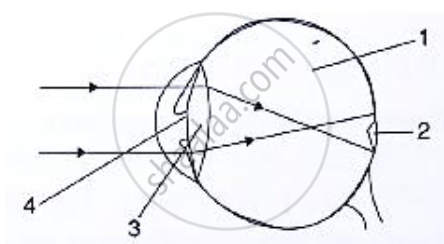
Name the defect shown in the diagram.
Have a look at the posture of this girl who is reading a book and answer the questions which follow:

Name the problem she is facing.
When do we consider a student sitting in the class to be myopic? List two causes of this defect. Explain using a ray diagram how this defect of eye can be corrected.
Given alongside is a diagram depicting a defect of the human eye. Study the same and then answer the questions that follow:
(i) Identify the defect.
(ii) Name the parts labelled 1, 2 and 3.
(iii) Give labelled two possible reasons for this eye defect.
(iv) Draw a labelled diagram to show how the above mentioned defect is rectified.
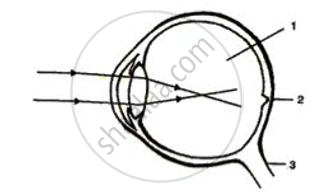
Given below is a diagram depicting a defect of the human eye? Study the same and answer the question that follow :
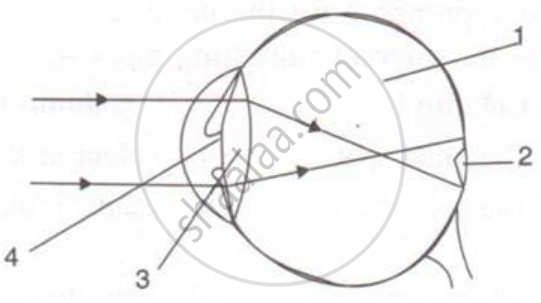
Name the type of lens used to correct this eye defect.
Given below is a diagram depicting a defect of the human eye? Study the same and answer the question that follow:

Draw a labeled diagram to show how the above mentioned defect is rectified using the lens named above.
Rewrite the following table so as to match second and third column with first column.
|
Column I
|
Column II
|
Column III
|
|
(i) Myopia
|
Old age problem
|
Bifocal lens
|
|
(ii) Presbyopia
|
Nearsightedness
|
Concave lens.
|
Name an old age eye defect. Why is it caused?
Give Reason:
Why do we see clearly in the central region of the retina?
Give Reason:
Older people require glasses to read and write.
Explain the Term: Hypermetropia
Name the following:
The defect of the human eye caused due to the uneven surface of the cornea.
Complete the following sentence with appropriate word :
An inability to focus on nearby objects due to loss of elasticity of the lens with age is called Iris.
Nearsightedness: elongated eyeball : : farsightedness: _______
Myopia and hypermetropia can be corrected by:
Observe the figure whether it is correct or not and explain the phenomenon.

State reasons for Myopia. With the help of ray diagrams, show the:
- image formation by a myopic eye, and
- correction of myopia using an appropriate lens.
A person is unable to see clearly a poster fixed on a distant wall. He however sees it clearly when standing at a distance of about 2 m from the wall.
- Draw ray diagram to show the formation of image by his eye lens when he is far away from the wall.
- List two possible reasons of this defect of vision.
- Draw ray diagram to show the correction of this defect using appropriate lens.
Name the following:
Two kinds of accomodations.
